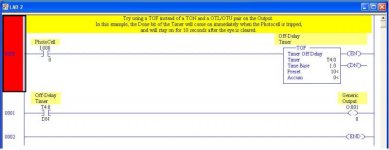I am making a Allen Bradley PLC500 ladder logic program for a ferris wheel application and cannot get my latch( a photocell) when 'someone' steps off the photocell...here is an example of a part of my program:
[I:2/4]------------------------TON
[T4:1/EN]--------------------[OTL]
[T4:1/DN]--------------------[OTU]
Is there a way to keep the OTL latched when the I:2/4 becomes XIC? Any help will be appreciated. thanks.
[I:2/4]------------------------TON
[T4:1/EN]--------------------[OTL]
[T4:1/DN]--------------------[OTU]
Is there a way to keep the OTL latched when the I:2/4 becomes XIC? Any help will be appreciated. thanks.







